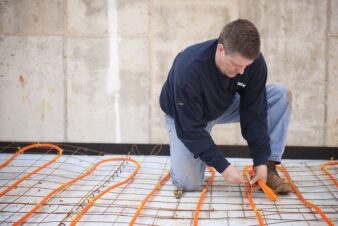I was called out to play boiler detective this week at a rental home where the tenants had been complaining of little to no heat for a few days. This particular client had interviewed me a few months back in search of a new boiler contractor to take care of situations just like this in their ten plus rental properties. The complaint from the tenant was lack of heat, the information from the management guy was more along the lines of “No pressure” or “Must be a bad pump again…” So like any other service call I made sure I had the essentials on the truck before setting out amidst one of the worst cold spells in recent history.

When the property owners and I have been exchanging emails and phone calls for a couple months now about various energy rebate programs, annual service contracts and maintenance agreements. I have been to nearly all of their properties to inspect the simple heating systems that reside within what are typical rambler (or ranch) style homes built in the 50’s & 60’s on the north side of the Twin Cities Metro area. All the units have copper fin-tube baseboard, cast iron radiators, copper mains, steel boiler piping and some are a combination of each.
The previous contractor taking care of these properties had done little modifications to the original installs as I could see it. They had been the original installers for a handful of the homes as well. There is no doubt they were highly qualified and capable of properly maintaining each and every one of the boiler systems at play.
As I arrived to the house the indoor temp was hovering at about ten degrees below the desired temp and would not budge. Given the outdoor temps had plummeted two days before to a ridiculous -25°F and stayed there I was already considering that the boiler was just unable to keep up. I quicly changed my tune as I felt the baseboard in the entryway to be rather tepid, definitely not hot so I continued to check throughout the house. The bedrooms had the original cast iron radiators, they were cold to sort of warm but the baseboard throughout the house was even cooler.
Sometimes I think its good to spend a few minutes in the house/space to get a good idea of what the conditions really are instead of heading directly to the boiler. After all, even if you make a repair or adjust something that is obvious you need to have something to compare the changes to. For me, without witnessing the conditions before the repair there is little satisfaction that I have truly fixed the problem after the repair without something to compare to.
In this case the boiler was hot, firing on an aquastat to high limit [it was there when I arrived and I suppose it had been like that for a couple days] but no heat was getting to the emitters. Of course it has to be the circulator, right? But, and there always is one in a case like this, this system had what appeared to be a new pump and it was all lit up indicating proper working order. The red housing and blinking LED lights on the front would identify it as an ECM circulator that couldn’t be more than 3-5 years old. In my estimate, given the product popularity in this neck of fly-over land I would say it wasn’t more than 2 years old.
With only two zone valves and a boiler aquastat to control the system I easily eliminated the thermostats from the situation to ensure all components were working properly. They were. So once again everything was pointing to the new(ish) pump.
The next step was to remove the pump, luckily the previous contractor had installed isolation flanges. What I found next would surprise me and most others I have the privilege to learn from. I guess I was expecting the pump to have lost the connection between the impeller and the motor or for it to be corroded with rust. I was half right.
If you remember, the bedrooms had radiators and the rest of the house has baseboard. Well, because of the house’s age it was originally piped in black pipe. That’s no longer common around here; copper is pretty much the norm. Because of the iron piping and radiators throughout most of the system there are magnetic particles present in the boiler water. These particles are called iron oxides and they were to blame for the pump failure in this situation.
If you’re not familiar, ECM pumps utilize powerful magnets in place of the copper windings in the motor. These magnets are what helps the motors operate at such high efficiencies and consume such low amounts of energy to do so. But they’re magnets. And when you have magnetic particles in your heating system solution, without some sort of treatment and attempt to filter such particles, the pump is going to attract those particles to a point where it cannot function as needed. In this case, the pump was running, the impeller was intact but there was little to no fluid flow because of the buildup within the impeller housing.
Its not my opinion that ECM pumps shouldn’t be installed in such systems as described here. To the contrary, they can do a lot of good and live a long life if given a fair chance to do so. Installing a filter/strainer device such as the one I reviewed here a while back or many others available on the market will do the job.
Have you had similar problems? What are you doing to protect these costly pumps from falling victim to such system conditions? I’d like to hear from you, leave a comment below!
Eric Aune
Aune Plumbing, LLC
Mechanical-Hub




Join the conversation: